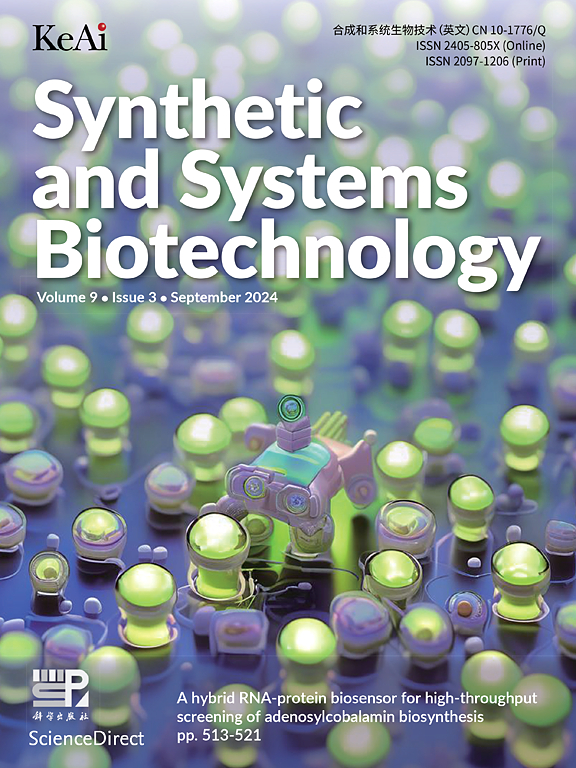终止子的调控意义:一种系统的方法来解剖终止子介导的上游mRNA稳定性增强。
IF 4.4
2区 生物学
Q1 BIOTECHNOLOGY & APPLIED MICROBIOLOGY
引用次数: 0
摘要
终止子的主要功能是终止基因表达中的转录。虽然一些研究表明终止子也对上游基因表达有积极的贡献,但这种影响的程度和潜在机制在很大程度上仍未被探索。本研究通过随机化5个核苷酸构建终止体突变文库,借助FlowSeq技术,根据下游荧光强度对终止体变异进行分类,并进行高通量测序,研究终止体强度与上游mRNA稳定性之间的相关性。为了研究终止子对mRNA稳定性的影响,通过cDNA测序对每个终止子变体的下游基因转录物的丰度进行了量化。结果表明,强终止子控制的转录本丰度平均是弱终止子控制的转录本丰度的2.2倍。此外,上游基因转录物的相对丰度较高可归因于几个明显的特征,包括发夹基部的高GC含量和U-tract下游的高at含量。此外,这些终止子的自由能在-28和-22 kcal/mol之间,茎长为14 nt。最后,这些特征被认为是上游有益终止子,在不同的表达系统中得到了验证。在三种不同菌株中加入RSF、GSH和HIS下游的最佳终止物,发酵产量nmn、SAM和VD13显著提高30% ~ 70%。本文的研究结果揭示了终止子特征有助于上游mRNA的稳定性,为基因电路设计提供了指导原则。本文章由计算机程序翻译,如有差异,请以英文原文为准。

Regulatory significance of terminator: A systematic approach for dissecting terminator-mediated enhancement of upstream mRNA stability
The primary function of terminators is to terminate transcription in gene expression. Although some studies have suggested that terminators also contribute positively to upstream gene expression, the extent and underlying mechanism of this effect remain largely unexplored. Here, the correlation between terminating strength and upstream mRNA stability was investigated by constructing a terminator mutation library through randomizing 5 nucleotides, assisted by FlowSeq technology, terminator variants were categorized based on the downstream fluorescence intensity, followed by high-throughput sequencing. To examine the impact of terminators on mRNA stability, the abundance of downstream gene transcripts for each terminator variant was quantified through cDNA sequencing. The results revealed that the transcript abundance controlled by strong terminators was, on average 2.2 times greater than those controlled by weak terminators on average. Moreover, several distinct features could be ascribed to high relative abundance of upstream gene transcript, including a high GC content at the base region of hairpin, and a high AT content in downstream of the U-tract. Additionally, these terminators showed a free energy between −28 and −22 kcal/mol, and a stem length of 14 nt. Finally, these features ascribed the upstream beneficial terminator were validated across various expression systems. By incorporating the optimal terminator downstream of RSF, GSH and HIS in three different strains, the fermentation productions-NMN SAM and VD13 exhibited a remarkable enhancement of 30 %–70 %. The findings presented here uncovered the terminator characteristics contributed to the upstream mRNA stability, providing guiding principles for gene circuit design.
求助全文
通过发布文献求助,成功后即可免费获取论文全文。
去求助
来源期刊

Synthetic and Systems Biotechnology
BIOTECHNOLOGY & APPLIED MICROBIOLOGY-
CiteScore
6.90
自引率
12.50%
发文量
90
审稿时长
67 days
期刊介绍:
Synthetic and Systems Biotechnology aims to promote the communication of original research in synthetic and systems biology, with strong emphasis on applications towards biotechnology. This journal is a quarterly peer-reviewed journal led by Editor-in-Chief Lixin Zhang. The journal publishes high-quality research; focusing on integrative approaches to enable the understanding and design of biological systems, and research to develop the application of systems and synthetic biology to natural systems. This journal will publish Articles, Short notes, Methods, Mini Reviews, Commentary and Conference reviews.
 求助内容:
求助内容: 应助结果提醒方式:
应助结果提醒方式:


